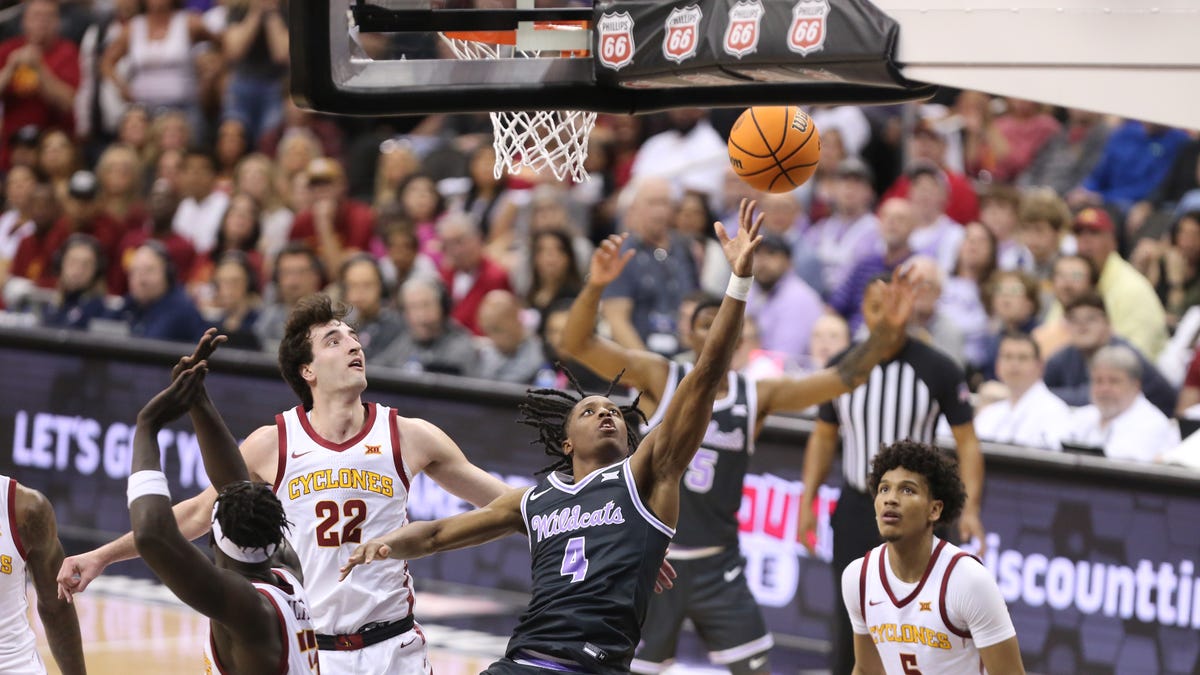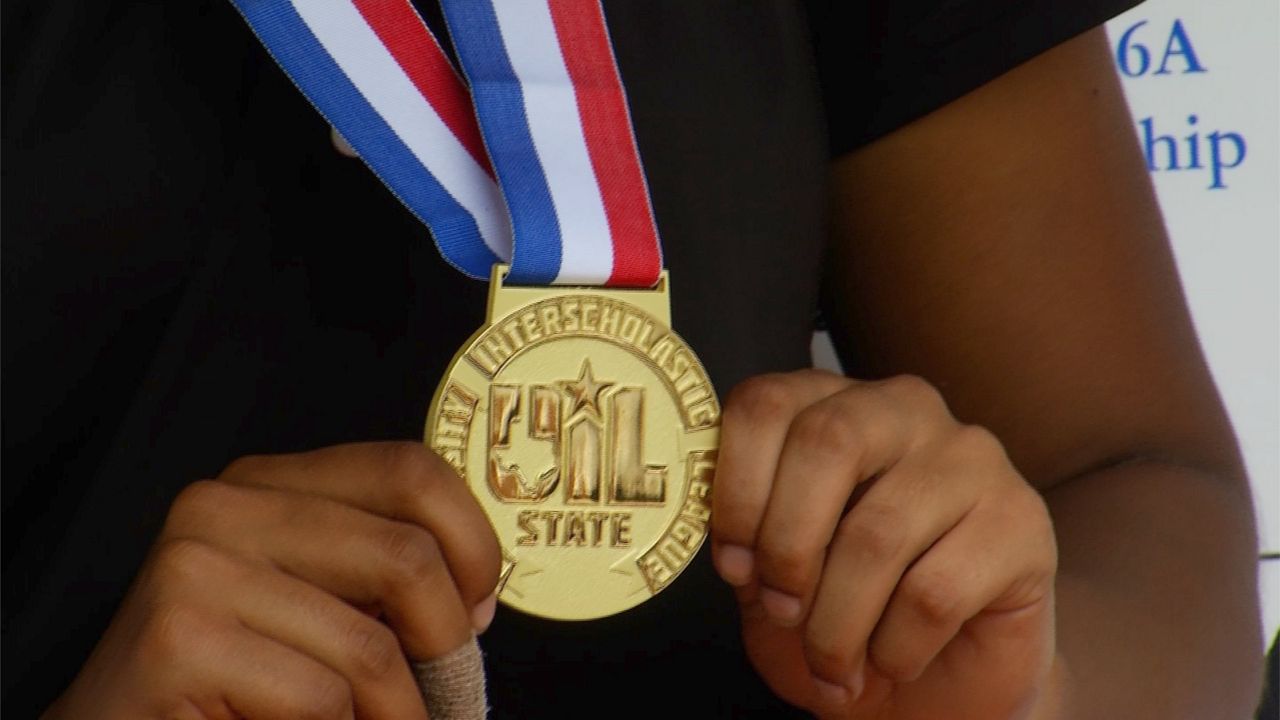Sports
BYU's venture into a new reality: 'We can't run from the tension'

PROVO, Utah — Members of The Church of Jesus Christ of Latter-day Saints dug a four-story hole along the foot of the Wasatch Mountains about a half-century ago. In that hole, they built an arena – a 22,000-seat temple, of sorts, that would stand as the largest on-campus facility in the United States. It would cover three acres and require a 2.5-million-pound roof requiring 38 hydraulic jacks to lift it over two weeks. Those Latter-day Saints knew of two things that could fill the place: the teachings of church founder Joseph Smith, and a Brigham Young University basketball team led by a Yugoslavian atheist named Krešimir Ćosić.
At a school steeped in divine heritage, this is a tradition of its own. Ćosić was recruited to BYU in 1968 from what the Deseret News, a Latter-day Saints-owned Utah newspaper, refers to as “a theological wasteland of communist rule.” He was 6-foot-11 and played like Pete Maravich. In his first season, Ćosić was one of at least three non-Mormons on the Cougars’ 1970-71 team. By the time the J. Willard Marriott Center opened for the ’71-72 season, he was a full-blown sensation. Ćosić packed the new arena and brought attention to the school — exactly what he was recruited to do. Perhaps more importantly, he converted to the faith, later translating the Book of Mormon into Croatian and returning home to introduce the church to Yugoslavia.
“One of the most legendary human beings, ever,” says Mark Pope, the Cougars’ current head coach.
BYU’s ambitions in athletics have always been dictated, to a degree, by the talent outside its orthodoxy. How does the school find it? How does it fit? The dynamic is a constant curiosity at the lone Division I university owned and operated by the church, where roughly 98.5 percent of the school’s 32,000-student undergraduate enrollment is Mormon, where diversity is scant, and where all students must enroll in prerequisite religious courses and conform to an honor code that forbids sex, alcohol, tobacco, tea, coffee, profanity and anything resembling same-sex interests. Also, no beards.
Like a football program that for decades maintained national relevance with a high-octane passing attack, a reliable stream of Polynesian talent, and a roster of older, physically mature return missionaries, BYU men’s basketball has long done things its way. It’s followed a pretty simple recipe: Land the best church member talent possible — the likes of Danny Ainge, Michael Smith, Jimmer Fredette, Tyler Haws, Yoeli Childs — identify a few non-member players who can fit in at the school, and fill out the roster with return missionaries. The results? BYU has made 30 NCAA Tournament trips, the most of any program without a Final Four appearance, and regularly ranks in the top 10 nationally in attendance.
Such results are infinitely small in the grander scheme, though. On-court success is required at BYU not for banners, but for the mission. As the school sees it, winning begets attention, attention begets interest, interest spreads the word. During a recent conversation in his office, university advancement vice president Keith Vorkink, who oversees BYU athletics, leaned forward to explain, “It would be remarkable if people could understand how much interest there is from the leadership of our church in our athletic programs. They’re not thinking, let’s go win a championship because that’s cool.”
That leadership might not roam the halls of the athletic department, but it’s ever-present. Latter-day Saints believe the president of their church is a living prophet, one who receives revelations from God. The Quorum of the Twelve Apostles has final authority in all church matters.
Well underneath them all is a 51-year-old Pope, the one who’s tasked to figure this all out.
How to be all things to all people, how to compose a program that many in the church still believe should primarily consist of church members, how to direct a program at a school that some outsiders paint as misguided and dated.
And, most urgently, how can Mark Pope and the Cougars accomplish this in a radical new world — amid contours dictated by name, image and likeness opportunities and transfer portal transactions, and as new members of college basketball’s best league, the Big 12.
This is not the same job Pope first accepted six years ago.
“We wrestle with this,” Vorkink says. “When I visit with Mark, we say, ‘We gotta live in the tension.’ That’s how we describe it. We can’t run from the tension.”
A few weeks into conference play, coming off a frustrating road loss at Texas Tech, and in the throes of preparation for a game against top-five Houston, Pope began a team video session by crossing one enormously long leg over the other and asking a question rarely heard in big-time collegiate athletics nowadays.
“OK,” Pope said, wide-eyed, “tell me something interesting you guys learned in school today.”
Roughly three decades after taking a yearlong Biblical Literature class at Washington, and courses on Islam after transferring to Kentucky, Pope still operates with this mobile curiosity of faith and education. He carried it through an NBA playing career that ended in 2005. He carried it when walking away from med school in 2009 to enter coaching. Pope climbed to an assistant position on legendary BYU coach Dave Rose’s staff from 2011 to 2015 before landing the head job at Utah Valley, six miles from Provo in Orem, Utah. He returned to BYU four seasons later to replace Rose, taking the Cougars to the first (and only) NCAA Tournament appearance of his tenure in 2021. Coaching at BYU, Pope says, requires “a concept of something bigger than yourself.”
From the back row, Aly Khalifa, a junior history major, said he was trying to decide between potential term paper subjects. The British colonization of Egypt or the Israeli occupation of the Sinai Peninsula.
“Heavy stuff,” Pope said, nodding. “I like it.”
Khalifa grew up along the Mediterranean coast in Alexandria, Egypt. A promising young player following in his sister’s footsteps, he was tabbed to participate in the NBA Global Academy in Australia as a teen. There, he drew the attention of U.S. college coaches, ultimately landing a scholarship to Charlotte. He played two seasons before entering the transfer portal.
“When BYU called, I knew nothing about Mormons, but I knew they were joining the Big 12,” Khalifa said recently. “That was good enough for me.”
Khalifa is a pear-shaped 6-foot-11 center with slow feet and little lift. A bum knee requires surgery, but he’s opting to play through the season. He doesn’t practice, occasionally misses playing time, and is admittedly out of shape. He is also spectacular. At its best, Pope’s ever-moving, ever-cutting, ever-shooting offense administers a long injection of novocaine. Then Khalifa makes a read and pulls the tooth. He is such a good passer that he ranks first among all Big 12 players in conference assist rate. The rest of the top 10 are guards measuring under 6 feet 4.
With Khalifa, you know the pass is coming, then watch as he makes it anyway. Folks in Provo have come to call him “Prince Aly” and “The Egyptian Magician,” which, in the year 2024, at a school that’s more than 80 percent White, can raise an eyebrow. Pope pulled Khalifa aside early in the season to see if there was any unease. Khalifa’s feeling on it: “I’m used to it. Sometimes it’s cringey, but it’s fun.”
Pope attempted to ease Khalifa’s transition to BYU last summer by traveling to Egypt to meet his parents. Pope, a member of the church, had to decline when offered tea, but otherwise charmed his audience.
Khalifa emerged this season when fan favorite Fousseyni Traore battled knee and hamstring injuries. Traore was a second team all-conference selection last year in the Cougars’ final West Coast Conference campaign. He’s 6 feet 6, 250 pounds and plays with a cornered desperation. He dips his shoulder like he’s opening a jammed door and moves whatever’s on the other side. In a recent win at West Virginia, Traore scored most of his season-high 24 points over the outstretched arms of 6-foot-11 defensive specialist Jesse Edwards. In Provo, they yell “Foooooouss,” every time he muscles one in.
Traore is from Bamako, Mali. He is, as Pope put it, “everything that we want our kids to aspire to be.” Now 22, Traore moved to the U.S. alone in 2018 with only a backpack. He lived with a Utah host family and enrolled at Wasatch Academy, a rural boarding school 60 miles south of Provo, not knowing, as he says, “anything or anybody.” He now speaks French, Bambara and English, and is pursuing a business degree. Pope speaks of Traore as the player who’s too good to be true — posted up in a side room of the basketball office, sitting with an accounting tutor as the coaching staff leaves at 9 on a weeknight.
“We don’t understand what a day’s work is compared to Fouss,” Pope says.
Pope traveled to Mali in the spring of 2022 to meet Traore’s family. He returned alongside Traore that fall to meet with government officials in Bamako about creating a non-profit. The Minister of Land granted 20 acres of land near the airport to The Fouss Foundation for construction of a sports complex with three indoor courts and training facilities.
Pope did the same with Atiki Ally Atiki, flying alongside the 6-foot-10 forward for a trip this past summer from Salt Lake City, to Amsterdam, to Dubai and, finally, to Tanzania. It was Atiki’s first return visit since leaving home in 2017; back when, speaking only Swahili, he enrolled at the London Basketball Academy in London, Ontario, Canada. Using funds raised by a 501(c)(3) in his name, Atiki and Pope delivered laptops, shoes and basketballs to schools in Mwanza and Dar es Salaam. Kids swarmed Atiki and local news stations broadcast the visits. “I looked around, thinking it was a dream,” Atiki remembers.
The visit was also a chance for closure. In 2020, amid the early stages of the coronavirus pandemic shutdown, Atiki’s father died while his son was 8,000 miles away in Canada. Atiki never said goodbye, never grieved with his family. So arriving in Mwanza, the first stop was an overgrown gravesite. There, Atiki fell to his knees, sobbing. He found a discarded garden spade and cleaned the headstone under an unrelenting morning sun. He “needed to do my part, needed to pray, needed him to hear me.”
“Bearing witness to that,” Pope now says, “was sacred.”
Back at BYU, Atiki is in his third season as a reserve forward. He met a University of Utah student, Jenae, last year and was swept away. The wedding will be this June.
“This guy wanted to play college basketball and found his way to BYU, of all places, and somehow it worked,” Pope says.
For Pope and his staff, of which two assistant coaches are non-church members, these aren’t stories of progressive recruiting. It’s simply building a team that can compete, by any means necessary.
Much of the BYU roster is, in fact, exactly what those who see BYU ranked in the AP Top 25 would expect. A collection of return missionaries who 1) are older and 2) shoot and pass with devout fundamentals. Of the 16 scholarship and non-scholarship players, nine served two-year missions for the church. They’re from Utah, and Idaho, and California. Four are married. Spencer Johnson and Trevin Knell, the team’s second- and third-leading scorers, are 26 and 25 years old, respectively. Johnson, who arrived at BYU after stops at Weber State and Salt Lake Community College, is expecting his first child this month.
But there’s also an unquestionable lack of convention here, at least by BYU’s standards. University chaplain James Slaughter, who interviews every incoming non-church member student, believes this to be the only team in school history (in any sport) with three Muslim players on the roster. The fit is a natural one, he says, as the honor code aligns closely with Islamic law.
But there’s also senior high-major transfer Jaxson Robinson, the team’s leading scorer, a Christian from Oklahoma with two previous stops at Texas A&M and Arkansas. There’s injured freshman high-major transfer Marcus Adams Jr., a non-church member, former top-50 recruit, who enrolled at Kansas and Gonzaga before opting for BYU.
Then there’s Noah Waterman. The Cougars’ leading rebounder and most versatile defender was home-schooled by a single mom as the youngest of nine kids in what he calls “a big hippie family.” He’s from Savannah, N.Y., about 30 miles east of Palmyra, where 14-year-old Joseph Smith said he had a vision in 1820 and later published the Book of Mormon. But Waterman is Baptist.
“I didn’t know what I was getting into coming out here, you feel me?” Waterman said late last month, perched in a seat in the Marriott Center.
After starting college at Niagara, Waterman landed at BYU via Detroit Mercy, which couldn’t be any more different than Provo unless it were on the moon. He struggled, maybe bent some rules. The fit was “a disaster,” per Pope. Over the summer, though, things changed.
“It took a while to buy in,” Waterman explains, “but I found that focus. It’s different here, but I needed it.”
That said, Waterman still has to be mindful. His alter ego, whom he calls “New York Noah,” often wants to come out.
“He wants to say what’s on his mind,” Waterman says, “but you can’t do that here.”
BYU’s Jaxson Robinson and Atiki Ally Atiki celebrate at the Vegas Showdown on Nov. 24, 2023. (Jeff Speer / Icon Sportswire via Getty Images)
A little before 11 a.m. on a recent Tuesday, streams of BYU students and community members moved orderly along sidewalks and across the spiral ramp bridging the campus to the Marriott Center. Traffic around the arena slowed. Everyone stops at yellow lights in Provo.
The Marriott Center has been modernized over the years, now boasting the 10th-largest capacity in college basketball. It still plays dual roles. On this morning, a celestial blue carpet covered the floor and nearly all 18,987 seats filled for a devotional featuring Elder David A. Bednar of the Quorum of the Twelve Apostles. The theme was “God’s wondrous works” and Bednar told the gathered masses, “There are no spiritual shortcuts or quick fixes.” Thousands upon thousands of students silently listened to the half-hour testimony, many jotting notes.
Meanwhile, the Houston basketball team used BYU’s practice gym — not the home team’s arena — to prep for a 7 p.m. tipoff.
That night, the visitors would see no evidence of the devotional. Marriott Center was remade in a matter of hours into a jam-packed, rollicking college basketball venue.
There are certain quirks and contradictions that arise, major and minor, at the confluence of what BYU is and the world of big-time, big-money athletics. The dynamic now is becoming more dramatic than ever. In joining the Big 12, the school made the cut in conference realignment’s great fissure between the haves and the have-nots. For BYU, it’s no more bantam leagues or independent status in football. The Cougars are now mainstream.
With that comes a different reality. No other power conference school is so tied to its ideology.
Vorkink regularly tells Pope he has the hardest task of anyone in college athletics. BYU basketball has had historical success, but typically as an unorthodox outsider. Being limited to a majority Latter-day Saints roster serves as an inherent ceiling and creates what Vorkink describes as “historical insecurities” about what’s possible. The Cougs have advanced to the second weekend of the NCAA Tournament only once in the last 42 years. This season it’s playing potential NCAA Tournament teams night in and night out.
“Mark has a brutal job,” Vorkink says the day after a tough loss to Houston. “He’s a coach in the Big 12 and we’re asking him to do it a different way. There is an element that is like, we’re constraining him, we’re keeping him from just leaning into the way that people think about being successful in basketball. But we think there’s a space for a successful program that doesn’t do it like everyone else. Time will tell.”
It’s difficult to visit Provo and not wonder how this new world won’t require more. Maybe more non-Latter-day Saints. Maybe more transfer portal pieces. More NIL money. More everything.
The current era already has taken BYU basketball places it probably never expected to be. Multiple Muslim players. Multiple transfers. There are only so many high-major quality recruits from the church. For decades BYU has clawed to compete with other schools for them (notably rival Utah) and waited out their two-year missions. Right now, Collin Chandler, who signed in November 2021 as the highest-rated recruit in program history, is in London, England. How tenable is such a waiting game in a portal-driven era that’s thrown roster planning out the window?
In February 2022, Pope sent out a lineup with no Latter-day Saints among the starters for the first time in school history, drawing local headlines. In doing so, he also for the first time fielded a lineup with four Black players at a school that didn’t have a Black basketball player until 1974.
Maybe the program can go even further. It might have to, but that could defeat the real purpose here. Going all-in on sports is a great marketing play for the faith, but not if it conflicts with a divine mission.
“With our leadership, there’s absolutely awareness of what’s at stake, and I think there’s hope, but wariness,” Vorkink says. “The reality is, if things move so far in a certain direction, we’re out. We have to be able to achieve our objectives in order to be in athletics.”
Pope, for his part, is a believer. Sitting in an office that affords a clear view of the Wasatch Mountains, he says he thinks BYU can create a team that serves both the school and the sport in perfect symmetry. “It might sound like those can’t coexist,” he notes, “but they have to coexist.”
And when they do, he adds, it will be beautiful. It will be what it’s supposed to be. It will be something bigger.
And, God willing, it will win.
(Illustration: Daniel Goldfarb / The Athletic; photos: Chris Gardner, William Mancebo / Getty Images)

Sports
NASCAR driver belly-flops into massive flood on pit road as rain postpones race
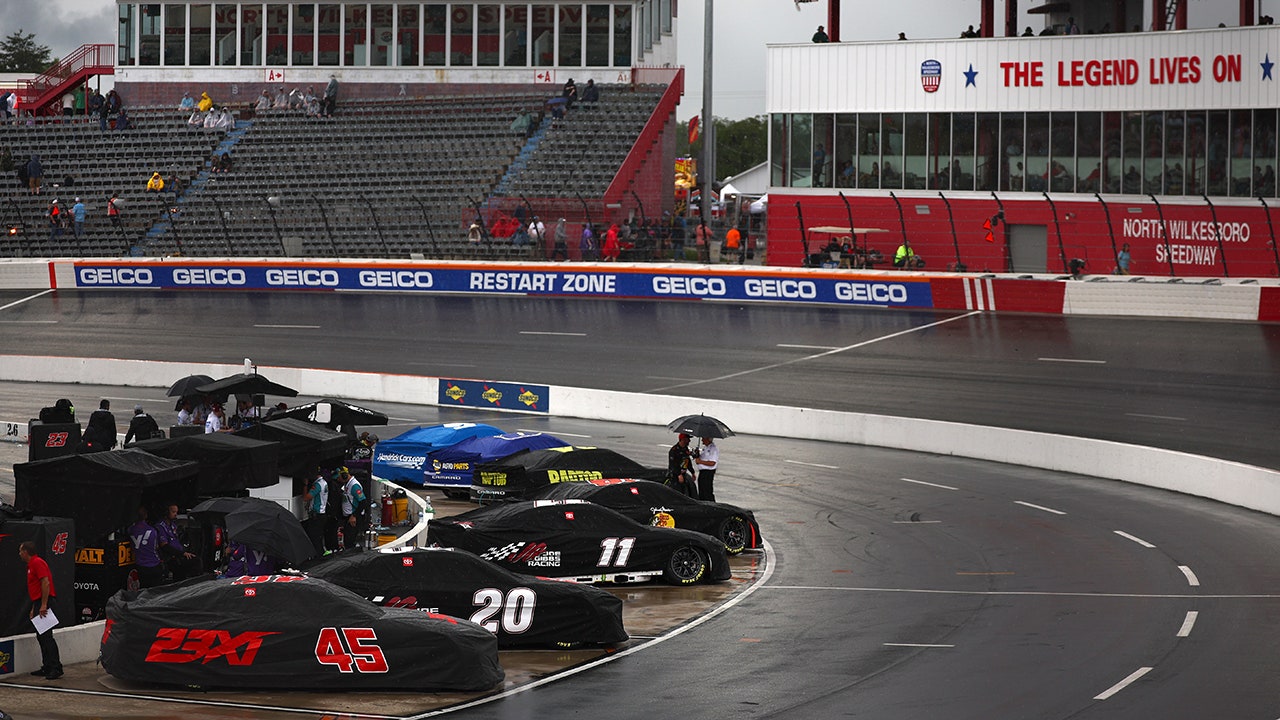
A monstrous rainstorm postponed Saturday’s NASCAR truck race, but those on the track still made the most of it.
The storm moved through North Wilkesboro, North Carolina, site of Sunday’s All-Star Open and Saturday’s Craftsman Truck Series Wright Brand 250.
Pole qualifying was canceled Saturday morning, but the race started on time, as positioning was set per the rule book. However, lightning in the area brought the red flag out on Lap 81 at roughly 2:30 p.m. ET.
Signage old and new at North Wilkesboro Speedway. (Jim Dedmon/USA Today Sports)
Fans were asked to clear the grandstand and take cover as rain began to fall.
NASCAR then announced at 5:05 p.m. ET the remainder of the race would be postponed until 11:30 a.m. ET Sunday, and heat races for the All-Star Open slated for Saturday were canceled. Positioning for the race will be set based on the rule book.
Rain flooded pit road so badly, it was roughly thigh-high for some on the track.

Air driers at work before qualifying at North Wilkesboro Speedway. (Jim Dedmon/USA Today Sports)
NASCAR STAR’S DAUGHTER BRINGS RACE-WINNING AMERICAN FLAG TO SCHOOL: I’M SO ‘PROUD’
One person in a video taken by FOX Business senior producer Justin Freiman could be seen swimming and diving in the water.
A few seconds later, a driver did a belly flop.
The weather affected racing Friday night, as well. All-Star Race qualifying and a pit crew challenge at North Wilkesboro Speedway scheduled for Friday night has been postponed due to rain.
NASCAR announced Saturday and Sunday tickets would be honored Sunday with some stipulations.
Saturday ticketholders will receiver “priority seating” for the finish of the truck race, while those who have tickets for Sunday will then get seating for the All-Star Race, in the event of same-seat purchases.
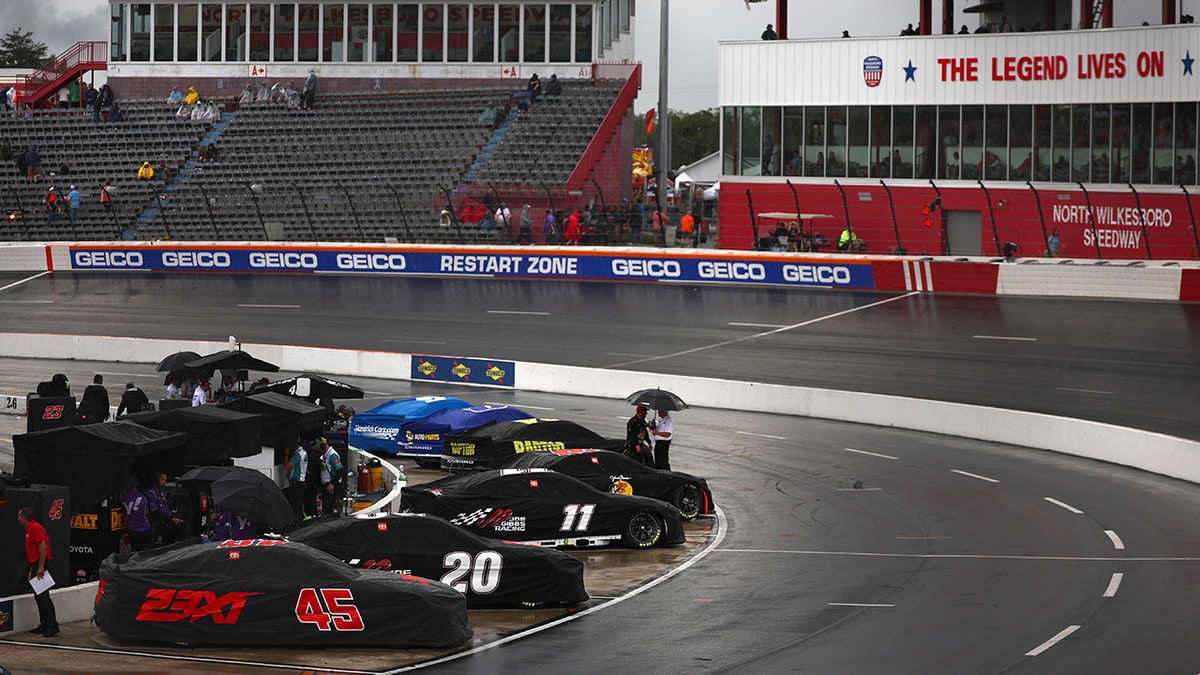
Cars covered and parked on the grid during a weather delay in qualifying for the NASCAR Cup Series All-Star Open at North Wilkesboro Speedway May 17, 2024, in North Wilkesboro, N.C. (Jared C. Tilton/Getty Images)
Twenty drivers will participate in the $1 million All-Star Race following the conclusion of the Wright Brand 250.
The Associated Press contributed to this report.
Follow Fox News Digital’s sports coverage on X, and subscribe to the Fox News Sports Huddle newsletter.
Sports
Carson wins City softball title on Alana Langford's 14th-inning homer
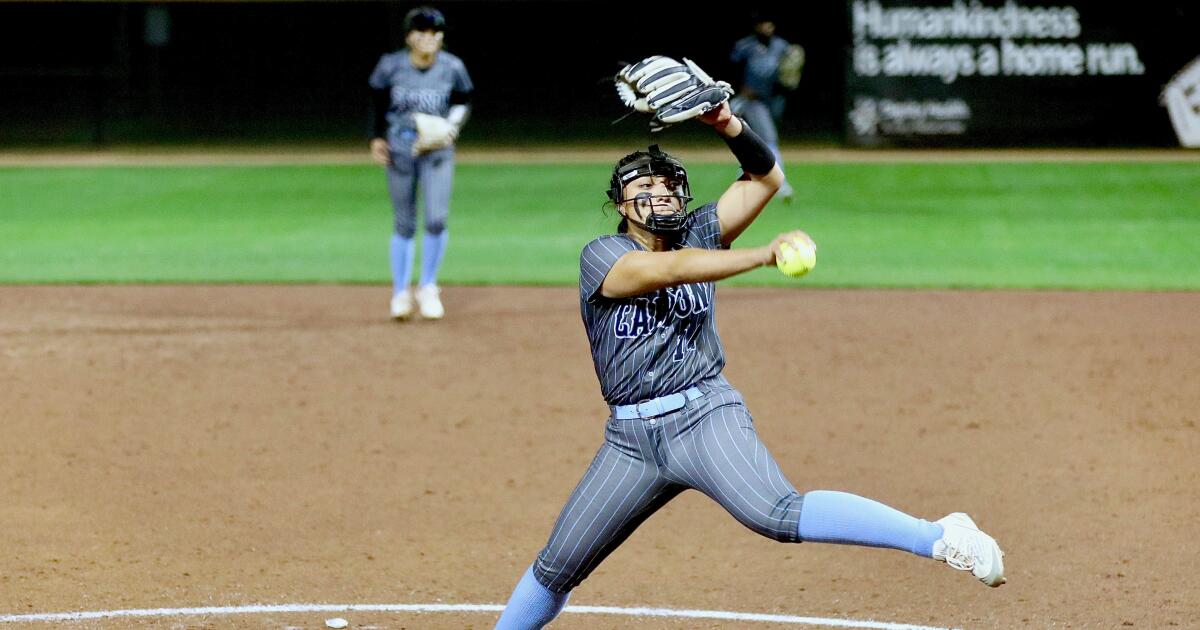
All night long, Alana Langford was waiting for her pitch.
It finally came with one out in the top of the 14th inning Saturday night in the City Section Open Division softball final and the first baseman did not miss it, working the count full and launching the ball high over the left-field fence for a home run that ultimately gave Carson a 1-0 victory over Granada Hills.
The contest took four hours and two minutes and fans at Long Beach State were treated to one of the best and longest playoff games in City history, lasting four hours and two minutes.
It was the second year in a row that Langford hit a game-winning homer in the championship game, having basted a two-run shot in the top of the eighth inning last spring against the Highlanders.
“I could see their pitcher was getting tired and I told myself when she misses it, I gotta be on it,” Langford said. “This one means so much because I’m a senior and it’s my last time playing with my team. My dad’s our biggest fan, he watches from the outfield and he’s my target!”
Last year’s final ended 12-11, but on Saturday one run was all the Colts needed to defend their title, thanks to a herculean effort by junior pitcher Giselle Pantoja, who allowed only one hit with 17 strikeouts and seven walks in outdueling counterpart Addison Moorman, who struck out 19 batters in a five-hit masterpiece of her own.
Carson’s Alana Langford celebrates after a double for the game’s first hit in the seventh inning against Granada Hills in the City Section Open Division final on Saturday night.
(Steve Galluzzo / For The Times)
It was another heartbreaking loss for Granada Hills (28-3), which entered as the No. 1 seed. The only blemishes on their record were a pair of one-run losses to Southern Section programs Warren and Harvard-Westlake. A year ago, the Highlanders rallied for 10 runs in the sixth inning to even the score. This time they could not manage a single run against Pomale, who anticipated her moment in the circle in the title game.
“In the 12th inning I was pushing past my limits, but I just told my teammates, ‘You got me, I got you!’” Pantoja said. “The last inning I was so tired and they have really tough hitters. I’ve been preparing for this since last season.”
Granada Hills, seeking its first section title since 1981, had two on and two out in the bottom of the 14th when Zoe Justman flied out to Riannah Maulupe and Colts players poured from the dugout to hug their heroic pitcher.
The game’s first hit did not come until the top of the seventh when Langford doubled over the left fielder’s head with one out, but Moorman then induced back-to-back popouts on the infield.
Carson threatened in the top of the ninth when Ruby Grajeda hit a two-out single to right and Langford was hit by a pitch, but Atiana Rodriguez struck out to keep the game scoreless.
In the top of the 12th, Grajeda led off with a bloop single to left and Langford followed with a bunt single. After a strikeout and a fly out, Alyssa Villasenor was hit by a pitch to load the bases, but on a 3-2 count Sandoval struck out looking
In the bottom half of the 12th, Samantha Esparza smacked the ball through the right side and slid into first base ahead of the throw by Carson right fielder Kaleigh Allen for the Highlanders’ first hit and advanced to second on Malia Plourde’s sacrifice bunt, but after Justman struck out, Jeniece Jimenez grounded out.
Carson has won five City titles — all in the upper division.
In the preceding Division I final, top-seeded Garfield (20-5) beat No. 3 Kennedy 5-2 and in the first game of Saturday’s City triple-header No. 1 Chatsworth beat No. 2 Marquez 12-2 in five innings for the Division II title.
Sports
Seize The Grey wins 149th Preakness Stakes; Mystik Dan finishes 2nd
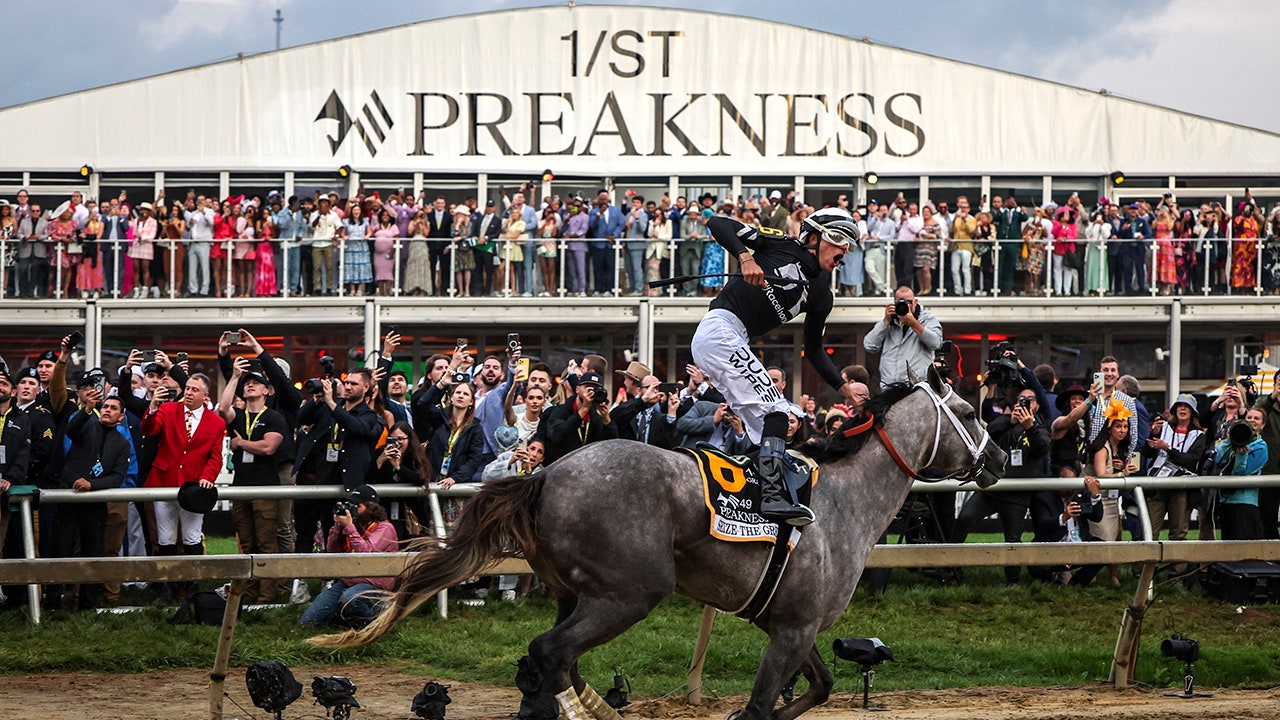
Seize The Grey won the 149th Preakness Stakes Saturday, closing at 9-1 odds, one of the longest shots on the board.
Mystik Dan, the winner of the Kentucky Derby, made a move late, but finished second in the field of eight horses running in the $2 million, 1 3/16-mile race.
It was a wire-to-wire victory for Seize The Grey, who led by several lengths at the ¾-mile mark, with Imagination trailing closely behind.
Jockey Jaime Torres, riding Seize the Grey, celebrates after winning the 149th running of the Preakness Stakes at Pimlico Race Course May 18, 2024, in Baltimore. (Samuel Corum/Getty Images)
Mystik Dan and Imagination both crept up, and as much as Mystik Dan tried to maneuver past the leader, nothing worked. Seize The Grey crossed the finish line first.
D. Wayne Lukas, 88, became the oldest trainer to win the Preakness, his seventh victory in the race, one shy of Bob Baffert’s record.
The original favorite, Muth, trained by the controversial Baffert, was scratched earlier this week due to a spiking fever. That led to Mystik Dan becoming the favorite in his quest to be the first Triple Crown winner since Justify in 2018.
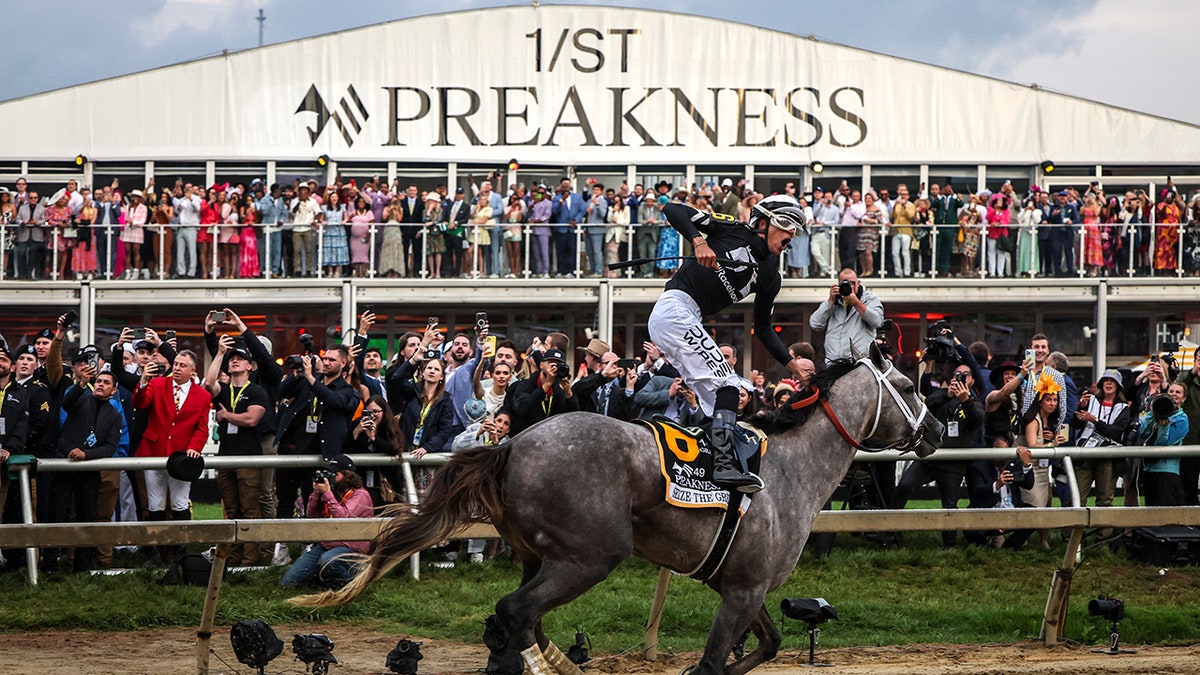
Jockey Jaime Torres, riding Seize the Grey, celebrates after winning the 149th running of the Preakness Stakes at Pimlico Race Course May 18, 2024, in Baltimore. (Samuel Corum/Getty Images)
Muth opened as the 8-5 favorite, ahead of Mystik Dan at 5-2 (he later closed at 2-1). Baffert said the horse was ruled out after reaching a temperature of 103 degrees Fahrenheit roughly 12 hours after arriving at the racecourse.
It was unknown for a bit whether Mystik Dan would run after his Kentucky Derby victory, but ownership decided he was good to go.
No one in the race’s 149-year history has saddled more horses in the Preakness than Lukas with 48 since debuting in 1980. He had two this time, with Just Steel finishing fifth.
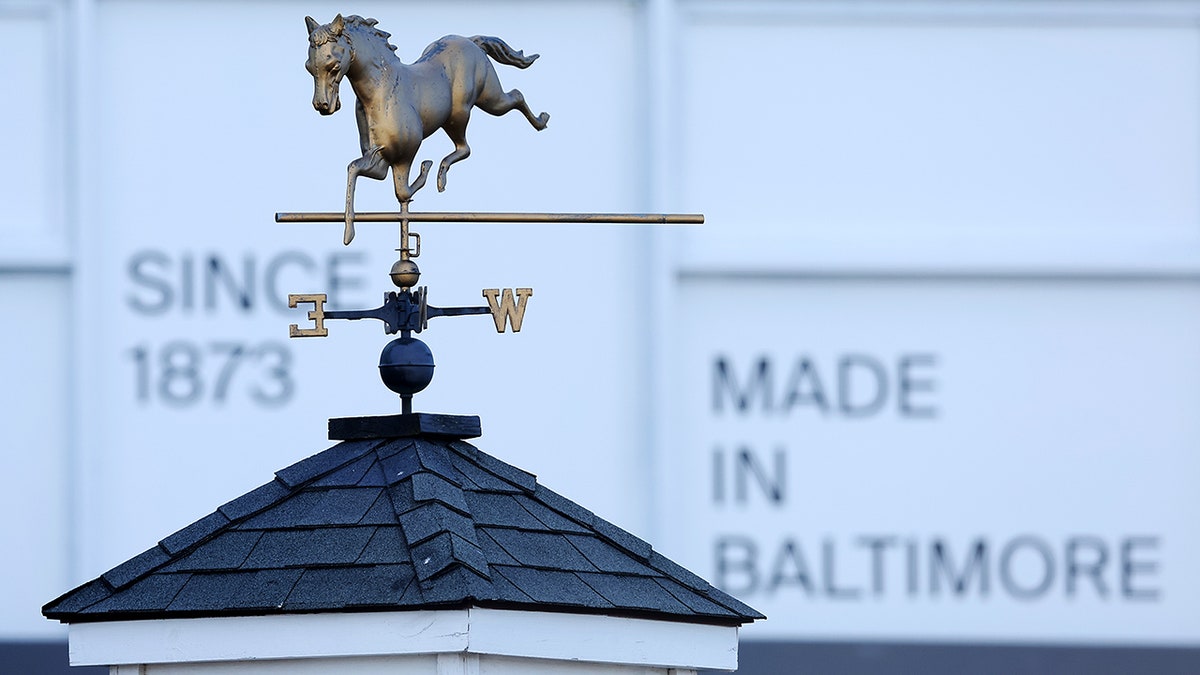
The wind vane at Pimlico Race Course ahead of the 147th Preakness Stakes May 18, 2022, in Baltimore. (Getty Images)
Baffert was at Pimlico after missing his third straight Kentucky Derby due to suspension. He is slated to be back at Churchill Downs in 2025. His National Treasure won last year’s Preakness.
The final leg of the Triple Crown, the Belmont Stakes, will take place at Saratoga Race Course June 8.
Fox News’ Paulina Dedaj and The Associated Press contributed to this report.
This is a developing story. Check back for more updates.
-

 Finance1 week ago
Finance1 week agoSpring Finance Forum 2024: CRE Financiers Eye Signs of Recovery
-

 World1 week ago
World1 week agoIndia Lok Sabha election 2024 Phase 4: Who votes and what’s at stake?
-

 Politics1 week ago
Politics1 week agoBiden’s decision to pull Israel weapons shipment kept quiet until after Holocaust remembrance address: report
-

 News1 week ago
News1 week agoTornadoes tear through the southeastern U.S. as storms leave 3 dead
-

 News1 week ago
News1 week agoThe Major Supreme Court Cases of 2024
-

 World1 week ago
World1 week agoA look at Chinese investment within Hungary
-

 Politics1 week ago
Politics1 week agoTales from the trail: The blue states Trump eyes to turn red in November
-

 World1 week ago
World1 week agoBorrell: Spain, Ireland and others could recognise Palestine on 21 May


